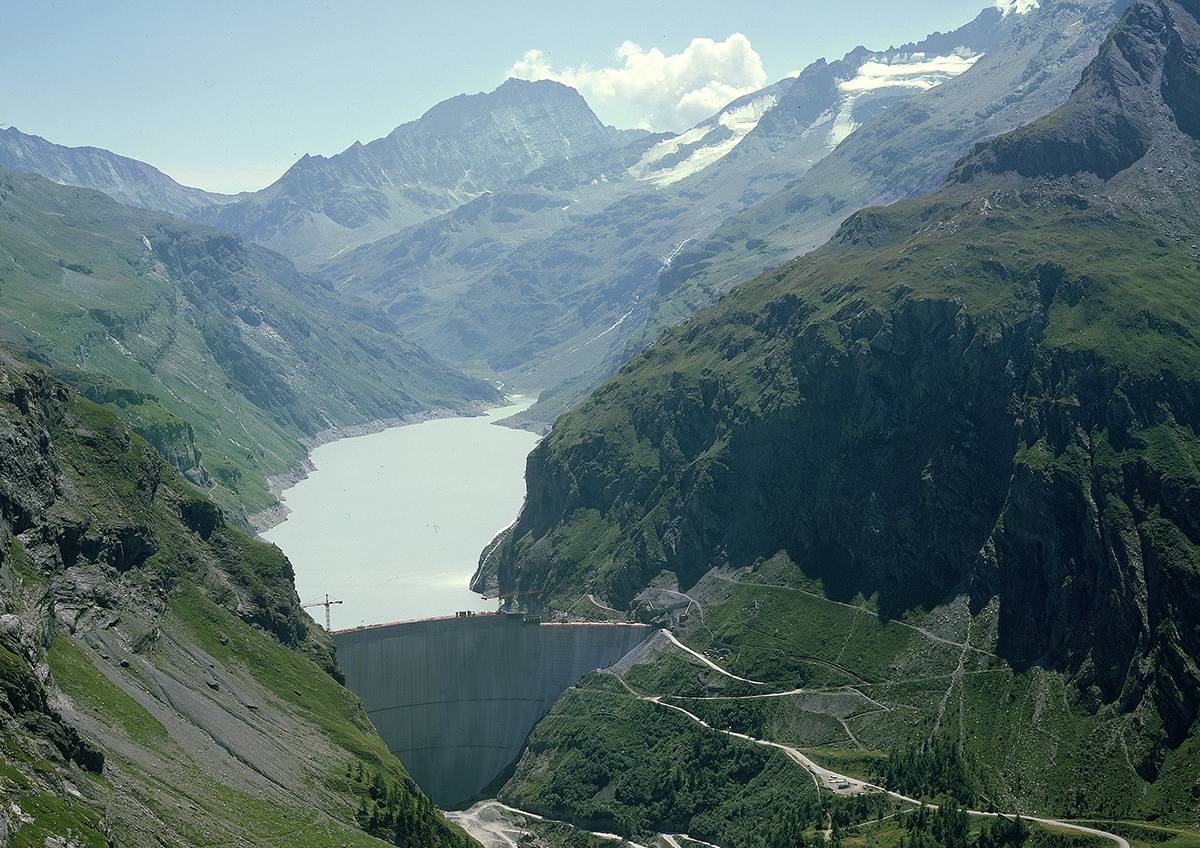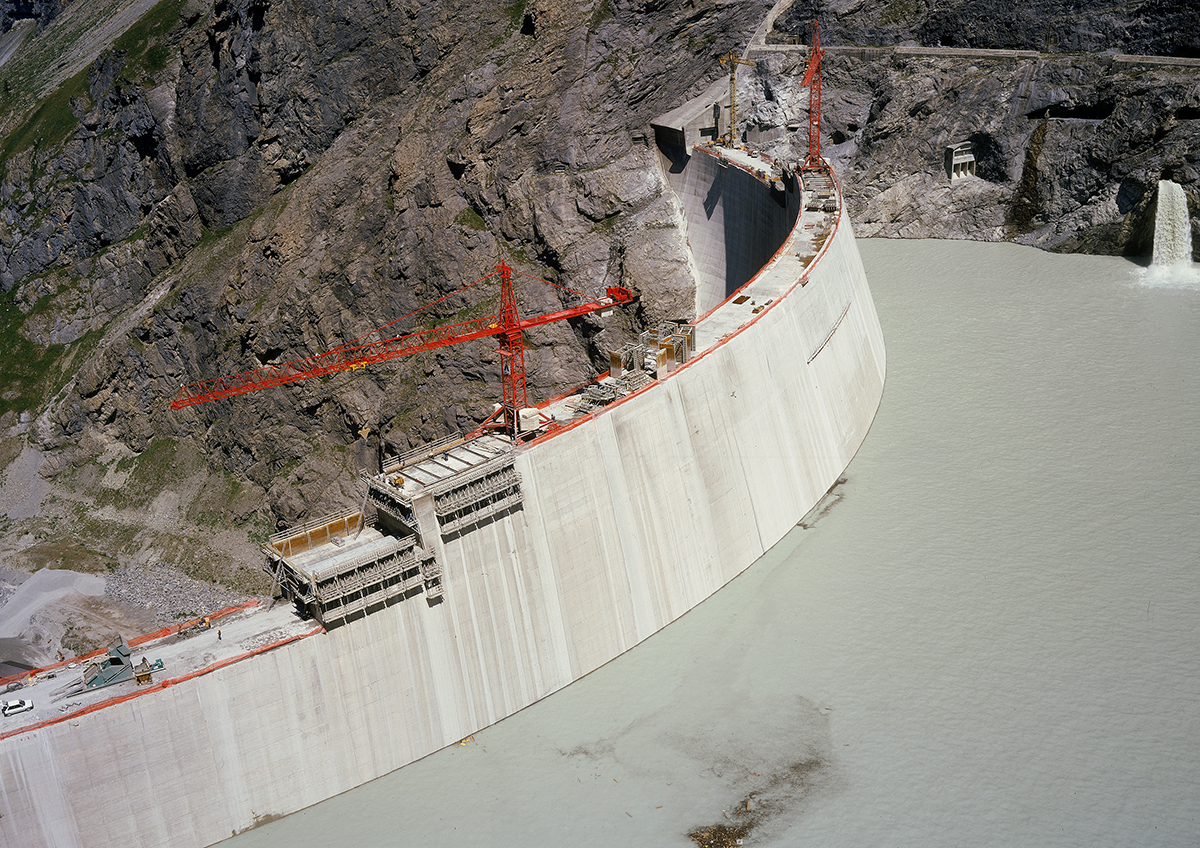The extension of existing hydropower reservoirs substantially contributes to the Energy Strategy 2050
With the implementation of the Energy Strategy 2050, the demand for seasonal storage of electricity increases. One option is to extend existing reservoirs of storage hydropower plants by heightening their dams. Researchers from the Laboratory of Hydraulics, Hydrology and Glaciology (VAW) at ETH Zurich evaluated the possibilities and potential benefits of heightening 38 dams in the Swiss Alps. They concluded: If 17 to 26 dams were heightened by up to 20 %, a total of 2.2 to 2.9 TWh of electric energy per year could be additionally shifted from summer to winter. This corresponds to the household electricity consumption of 1.7 to 2.2 million inhabitants during winter.
In an electric grid, the electricity production has to be in line with the demand at every moment. Run-of-river hydropower plants, nuclear power plants and new renewable energy sources such as photovoltaic and wind are not fully flexible to react to demand. Therefore, storage and pumped-storage hydropower plants are operated to balance the production and consumption of electricity. Due to lower runoff in winter, the electricity production from hydropower is relatively low while the electricity demand is higher than in summer. Therefore, artificial storage lakes (called reservoirs) mainly in the Alps are filled with water during spring and summer runoff in order to generate more electricity in winter. Such seasonal storage reduces the need for electricity imports in winter.
The Swiss Energy Strategy 2050 foresees a stepwise withdrawal from nuclear power and a considerable increase of electricity generation from new renewable energies, mainly photovoltaics. When the nuclear power plants will be phased out in the coming decades, the Swiss electricity production in winter will be significantly lower than today, also because production from photovoltaics is lower than in summer. Due to these future shifts in the Swiss electricity production, the need for large-scale seasonal storage of electricity increases.
Extending existing reservoirs to increase seasonal electricity storage
One way to respond to this increasing demand is to extend existing reservoirs of storage hydropower plants by heightening their dams. This was done in the last decades for some reservoirs in the Swiss Alps, e.g. Mauvoisin (VS), Luzzone (TI) and Vieux Emosson (VS). By heightening these dams by 6 %, 8 % and 39 % of their previous heights (measured from the deepest point of the foundation to the dam crest), the reservoir volumes increased by 17 %, 23 % and 93 %, respectively. Such considerable reservoir volume increases result from the fact that the valleys are wider at higher elevations above the riverbed.
A systematic potential study over Switzerland
To assess the energy potential of such reservoir extensions, researchers at ETH Zurich systematically investigated 38 existing reservoirs and corresponding dams in the Swiss Alps with a net storage volume of at least 20 Mio. m3 today. For the heightening of these dams by 5 %, 10 % or 20 %, they conceptually studied the required adaptations and rated them based on a set of eight criteria (Fuchs et al. 2019). They considered the additional reservoir areas, the dams with their auxiliary structures (e.g. spillways) and the corresponding hydropower plants. Then they sorted the heightening options by their rating and classified them into “well suited”, “moderately suited” and “not to be further investigated”. The researchers summarized the “well-suited” heightening options in one scenario, while they additionally considered the “moderately suited” options in a second scenario.

Mauvoisin dam during heightening in 1990. Raising the dam crest by 13.5 m, corresponding to 6% of the previous maximum dam height, increased the reservoir volume by 17%. This allows storing additionally 100 GWh of electric energy, which contributes to balance the electricity supply and demand over the year (ETH-Bibliothek Zürich, Bildarchiv, Comet Photo AG Zürich: http://doi.org/10.3932/ethz-a-000041277).
What is the energy potential of reservoir extensions?
If 17 or 26 of the studied reservoirs were extended according to the two scenarios, their storage volume would increase by 700 or 950 Mio. m3, respectively. With such reservoir extensions, today’s Swiss hydroelectric storage capacity of 8.8 TWh would increase by 2.2 or 2.9 TWh (Felix et al. 2020). This corresponds to an increase by 25 to 33 %. With the additional storage, 2.2 to 2.9 TWh per year could be additionally shifted from summer to winter. This amount of energy correspond for example to the household electricity consumption of 1.7 to 2.2 million inhabitants during winter. Hence, such reservoir extensions would be a valuable contribution to reduce the need for electricity imports in winter.
By heightening dams by up to 20 %, the exploitable elevation difference of the corresponding hydropower plants downstream of the reservoirs only increases by some 2 %. As a result, there will be no significant additional electricity generation over the year (<0.2 TWh/year). The value of extending hydropower reservoirs, however, lies in the additional production shift from summer to winter. Nowadays, some storage hydropower plants need to operate in late summer at maximum load also in periods of very weak demand, because the reservoirs are full. Reservoir extensions would contribute to reduce such situations and to better balance the electricity demand and production.
Further benefits of extended reservoirs
Besides hydropower, extended reservoirs could increasingly contribute to the protection against natural hazards, which means mainly floods. As multipurpose reservoirs, they can serve downstream communities and ecosystems by providing water for securing minimum flows in rivers and for irrigation during dry periods in the future.
Constraints and perspectives
The authors of the study assume that not all reservoir extension options can be realized due to technical, economical, ecological and social constraints. Given the limited alternatives and the fact that the planning and realization of reservoir extension projects may take 15 years, further studies on this subject are needed. To foster the implementation of the Energy Strategy 2050, they suggest to pursue both the upgrading of existing reservoirs with the corresponding hydropower plants and to investigate options for new hydropower plants. The latter could become feasible mainly at high altitudes, where additional areas have become and are getting ice-free due to glacier retreat. To reach the targets of the Energy Strategy 2050, further research as well as additional incentives are required.

The Mauvoisin dam during heightening in 1990 (ETH-Bibliothek Zürich, Bildarchiv, Comet Photo AG Zürich: http://doi.org/10.3932/ethz-a-000041279).
Blog Article
Read this article in the SCCER-SoE blog in German, French and English with more detailed biographies of the authors.
References
Fuchs H., Felix D., Müller-Hagmann M., Boes R. (2019): Bewertung von Talsperren-Erhöhungsoptionen in der Schweiz. WasserWirtschaft 109(5): 146-149.
Felix D., Müller-Hagmann M., Boes R. (2020): Ausbaupotential der bestehenden Speicherseen in der Schweiz. Wasser, Energie, Luft 112(1): 1-10.
